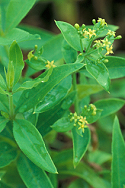
Photo © Steven Foster
Introduction
Rubia tinctoria is a perennial climber1,2,3 with tiny, pale, yellow-green to cream, starry flowersin loose clusters followed by fleshy, red-brown to black berries.1,2 This plant is indigenous to Europe, Asia, Asia Minor, and the Middle East.1,3,4 Madder is also known as European madder or common madder, which is different from wild madder (R. peregrina) and Indian madder (R. cordifolia).1,2 The roots of the madder are the part used.1,3
History and Cultural Significance
The name Rubia is from the Latin word ruber meaning red, referring to the red dye from the plant’s roots.1 Madder makes a permanent red dye called Turkey red that has been used traditionally to color Turkish fezzes, soldiers’ uniforms, and hunting jackets.1 Madder root is a natural source of red, pink, orange, apricot, lilac, purple, brown, and black shades of dye, ink, and paint.1,2 The plant was originally exported from Turkey for cultivation in the main textile centers of Northern Europe.1 In 1868, alizarin, the main pigment in madder root, was synthesized from coal tar, thus reducing market demand for the natural material.1,2,3 Madder is still used as a red dye in textiles.3
Madder root was mentioned by Pliny the Elder (23-79 CE) as a cure for jaundice.1 In traditional European medicine, prior to awareness of it potential toxicity, it was used for kidney and bladder stones and inflammation of the urinary tract.5 North African folk medicine used madder for anemia or blood diseases and as an aphrodisiac.1 Historically, it was used internally for menstrual and urinary disorders, edema (excess fluid retention), jaundice, and for preventing and disintegrating kidney stones.2,6 Madder was employed as a tonic, appetizer, and expectorant.1 Externally, it has been used for wounds, ulcers, and sciatica.1
In France, metal-work was polished with madder plant because of its spiny leaves and prickly stalks.2 The herb has also been used as fodder for animals.2 In India, the natural dye is used in crafts and there is a minor demand for it in craft dyeing and artists' paints in Western Europe and North America.3
Modern Research
Currently there are no human clinical studies available on the internal or external uses of madder root.
Future Outlook
With limited fossil fuels and raw materials, some nations are looking toward ecological farming for renewable raw materials, namely organically grown plant-based resources that are environmentally friendly and can be returned to the earth as part of their natural cycle.7 There has been increasing interest in natural dyes extracted from vegetable matter and animal residues because of a greater public awareness of ecological and environmental problems related to the use of synthetic dyes.4 The madder plant could potentially replace synthetic azo-pigments in the production of renewable raw material dyes.7 Larger growth is expected in the natural colorants market for food, drugs and cosmetics.4 However, industrial dye manufacturers are creating market competition in the U.S. and European Union with synthetic “organic dyes” that are less toxic than their standard synthetic dyes.4
Developing countries with long traditions of natural dye use may benefit greatly in the future because of their low labor rates that offset higher costs of natural dyeing processes and their constant supply of raw materials to extract dyes.4 Madder is still produced on a small scale in Kashmir, India and in Nepal, Iran, and possibly elsewhere to be exported globally.3,4 Japan and the U.S. import large quantities of madder for niche market consumption.4
References
1 Bown D. The Herb Society of America New Encyclopedia of Herbs and Their Uses. London: Dorling Kindersley Ltd.; 2001.
2 Grieve M. A Modern Herbal. Vol. 2. New York: Dover Books; 1971.
3 Food and Agriculture Organization of the United Nations. Major colourants and dyestuffs mainly produced in horticultural systems. In: Non-Wood Forest Products 4: Natural Colourants and Dyestuffs. 1995. FAO Corporate Document Repository. Available at: http://www.fao.org/documents/show_cdr.asp?url_file=/docrep/V8879E/v8879e09.htm. Accessed September 7, 2005.
4 Rural and Agricultural Incomes with a Sustainable Environment. Market and Technical Survey: Natural Dyes. Available at: http://www.raise.org/natural/pubs/dyes/dyes.stm. Accessed on September 7, 2005.
5 van Wyk BE, Wink M. Medicinal Plants of the World. Portland, OR: Timber Press; 2004.
6 Jellin JM, ed. Natural Medicines Comprehensive Database. Stockton, CA: Therapeutic Research Faculty; 2002.
7 National Activities - Austria. Forschungsforum 3/97 - Renewable Raw Materials, Pave the Way for Sustainability. Available at: http://www.biomatnet.org/secure/Other/S939.htm. Accessed September 7, 2005.
|